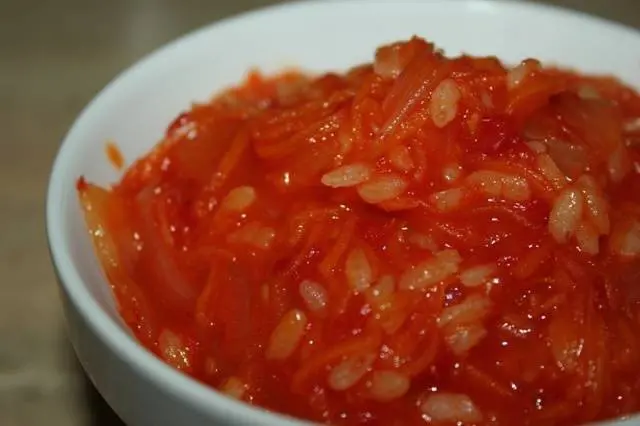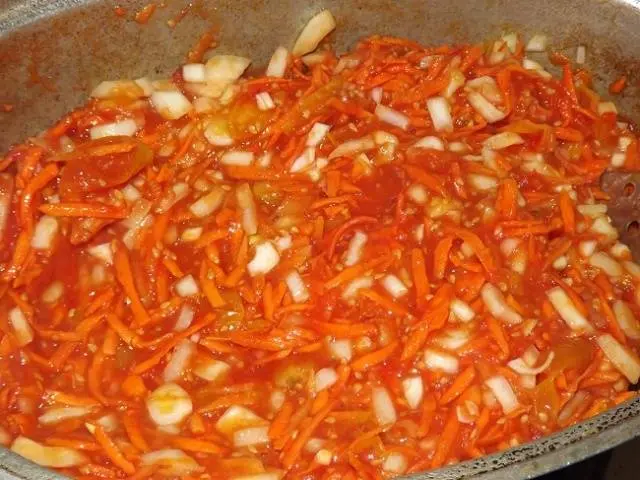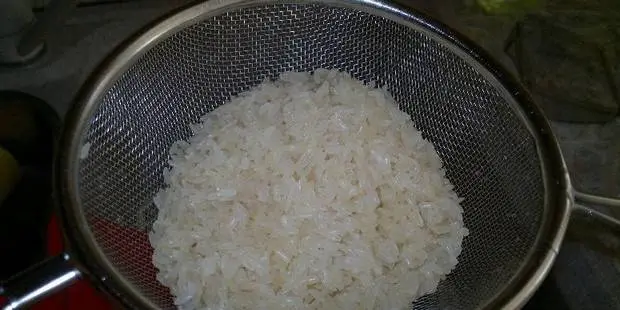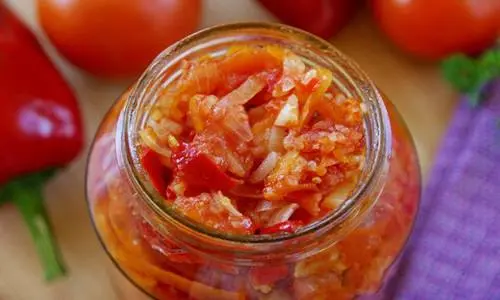Contents
Many people love and cook lecho. This salad has a great taste and aroma. Every housewife has her favorite recipe, which she uses every year. The classic lecho has very few ingredients, often only peppers and tomatoes with spices. However, there are other cooking options. The composition of such salads includes other ingredients that make it more satisfying. For example, housewives often add rice to lecho. It is this recipe that we will now consider.

Lecho recipe with rice
The first step is to prepare all the ingredients. For lecho with rice for the winter, we need:
- ripe fleshy tomatoes – three kilograms;
- rice – 1,5 kilograms;
- carrots – one kilogram;
- sweet bell pepper – one kilogram;
- onions – one kilogram;
- garlic – one head;
- table 9% vinegar – up to 100 ml;
- sunflower oil – about 400 ml;
- granulated sugar – up to 180 grams;
- salt – 2 or 3 tablespoons;
- bay leaf, cloves, ground paprika and allspice to taste.

Now let’s move on to the preparation of the salad. Peel the skin off the tomatoes. To do this, they are poured with boiling water and kept there for a couple of minutes. Then the water is changed to cold and they begin to carefully remove the entire skin from the fruit. Such tomatoes can not even be chopped with a meat grinder, but simply chopped with a knife. It won’t affect the taste in any way.
Next we move on to bell pepper. It is washed, and then all seeds and stalks are removed. It is better to cut vegetables into strips or slices. Next, wash and peel the carrots. After that, it is rubbed on a grater with the largest holes.

Then peel and chop the garlic and onions. A large 10-liter enameled pan is placed on the fire, chopped tomatoes, granulated sugar, salt and sunflower oil are placed in it. Be prepared to stir the contents of the pot very often. Lecho very quickly starts to stick to the bottom, especially after adding rice.
The contents of the pan are brought to a boil and boiled for 7 minutes, stirring regularly. Immediately after that, add all the chopped vegetables (sweet bell pepper, carrots, garlic and onions) to the container. All this is thoroughly mixed and again brought to a boil.
After the lecho boils, you need to throw your favorite spices into the pan. You can count on the following:
- allspice peas – ten pieces;
- cloves – three pieces;
- ground sweet paprika – one tablespoon;
- mustard seeds – one tablespoon;
- bay leaf – two pieces;
- ground pepper mixture – one teaspoon.

If you add bay leaf to the lecho, then after 5 minutes it will need to be removed from the pan. Only now you can add dry washed rice to the dish. The experience of many housewives shows that long rice (unsteamed) is most suitable for lecho. After adding the rice, the lecho is stewed for another 20 minutes so that the rice reaches a half-cooked state. Remember that at this stage it is very important to stir the salad frequently.

Rice should not be completely cooked. After seaming, the cans will keep warm for a long time, so that he can walk. Otherwise, you will not get lecho with rice, but lecho with boiled porridge. Before turning off the fire, pour vinegar into the salad.
Banks for lecho should be prepared in advance. They are thoroughly washed with dishwashing detergent or soda and rinsed well in water. After that, the containers are sterilized for 10 minutes. Then the jars are taken out of the water and laid out on a clean towel so that the water is completely glass.
Now pour the hot billet into containers and roll up with sterilized lids. We turn the containers upside down and wrap them in a warm blanket. After the salad has cooled completely, you can move the containers to a cooler storage place. From this amount of ingredients, about 6 liters of finished salad are obtained. And this is at least 12 half-liter jars of lecho with rice for the winter. Quite enough for one family.

Conclusion
Lecho recipes with rice for the winter may differ slightly from each other. But basically this delicious salad consists of peppers, ripe tomatoes, onions, carrots and rice itself. Everyone can add a variety of spices to the dish according to their taste. In general, the photos seen can only convey the appearance of the lecho, but not the aroma and taste. So stop surfing the internet and start cooking!









